In website development, coding files generate the look of a website.
Among coding files, some form the structure of the pages, while others define the styles of elements on your page.
Today, we'll have a look at CSS or Cascading Style Sheet files that define the style of a webpage. These files are responsible for making things look better in Internet browsers. In WordPress, you can find the style.css file in the Themes folder.
The style.css file contains the CSS code snippets that affect the look of your site’s pages. If you need to change the look of your WordPress site, you may need to find the respective sections in the style.css file.
Now let’s proceed to know about the CSS.
Note: Before making any changes, we recommend backing up your site, so there wouldn't be any issues later on if something breaks.
What Is CSS?
CSS (Cascading Style Sheets) is the language that defines the style of HTML documents. For elements on the pages, you can create CSS styles that define the position, structure, and presentation of the elements. An example of the CSS styles would be:
p {
color: red;
text-align: center;
} In Content Management Systems like WordPress, CSS styles are controlled by theme files. That means you don’t have to code styles separately.
On the other hand, in manual website development, you may need to create styles separately.
Find And Edit WordPress CSS Styles
Once you configure WordPress and proceed to install your theme, you don’t have to deal with CSS.
Every WordPress theme contains its style.css file. You can find one in the /wp-content/themes/themename/ folder. In this article, we will use the Visual Composer Starter Theme as an example.
The CSS file in a WordPress theme defines the style, structure, and colors of a WordPress website. However, if you want to change the code snippets in the styles, you will need to alter CSS via the WordPress Dashboard.
Step 1
Login to WordPress dashboard and proceed to click on the Theme Editor in the Appearance menu.
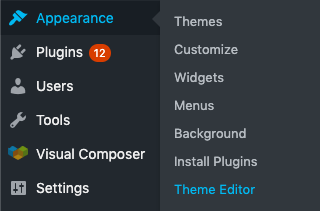
Step 2
The next page shows your theme’s style.css file, along with an editor that lets you edit the CSS code.
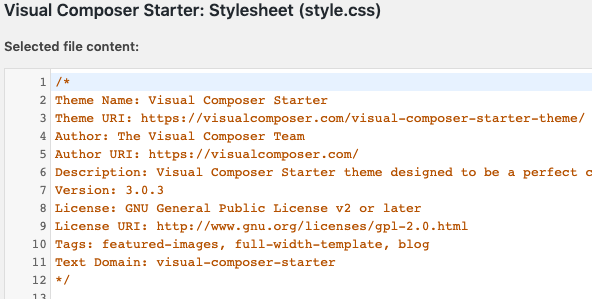
Step 3
On the same page, you can see a list of your theme’s code files. If you need to alter a file, you can click on the one you like and edit the code in the Editor.
Step 4
After you make necessary changes in the CSS, click on Update File at the end to save changes.
Finding CSS Styles
In the WordPress dashboard editor, you can see your site’s style.css file for making changes.
Basic Information About Your WordPress Theme
At the top of the style.css, you can see the basic information for your WordPress theme. This section outlines the theme name, version, author, description, home page URL, license, and copyright text.
Primary Sections In A WordPress Theme’s CSS File
Next, you can see the basic sections (styles) or code structure names of your WordPress theme.
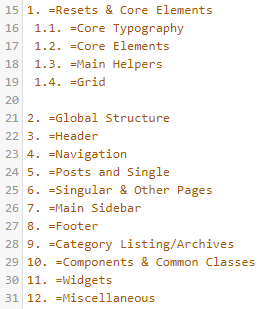
Finding The Code Snippets In The WordPress CSS File
Once you get the full list of styles in the WordPress theme, use CTRL+F to find different sections in the code. The main sections also contain sub-sections of the CSS code.
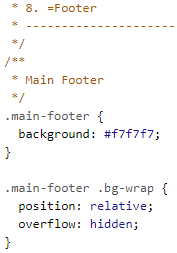
Finding CSS Styles With Chrome’s Inspect Feature
Alternatively, you can browse to the homepage of your site. Right-click on the section you want to change the CSS code for, and click on the Inspect in the short menu.
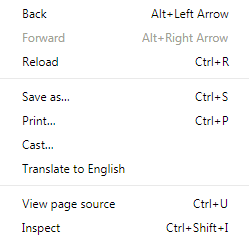
After clicking the Inspect option, you will see your browser screen has been divided into two sections.
Finding The Names Of CSS Styles On A Page
At the top of the right section, click on the arrow symbol and point at the different parts on the pages. As you point at the various parts on the page, you can see the respective CSS class or section name in the tooltip.

Edit The Style.css File
Now, get back to the style.css code in the WordPress editor. Search for the respective class or section in the code and make necessary changes. After you make changes, you can save the file and proceed to see the changes on the site.
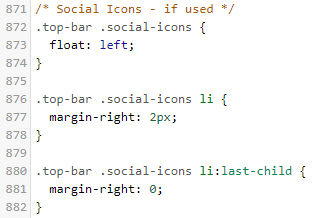
Purpose Of The Primary Sections In The WordPress Style.css File
The following list contains essential sections in a WordPress style.css file.
- Typography: This section includes configuration on your site’s font styles, size, and colors.
- Header: The top section of your WordPress site is referred to as the Header. Usually, it contains the menu bar and logo.
- Posts: This section controls the way your site’s titles, fonts, colors, and size information are displayed.
- Sidebar: The CSS section that holds information about your site’s sidebar. You can change the code to make necessary changes to your site’s sidebar.
- Footer: This is the bottom section of your WordPress site. It contains the footer links, social icons, legal pages, and copyright text.
We defined primary sections of the WordPress’ style.css file. As a beginner, you can search for the desired sections in the file and make necessary changes.
Additional Places To Use CSS In A WordPress Website
You can also use the WordPress Additional CSS option to make necessary changes to your WordPress website.
Point at the Appearance in the left panel and click on Customize in the short menu.
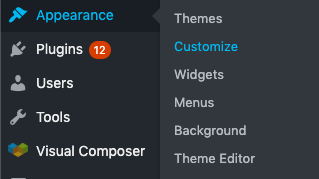
On the next page, you can see the Additional CSS option.
Paste in the CSS code and save changes. You can see the results in the live customizer.
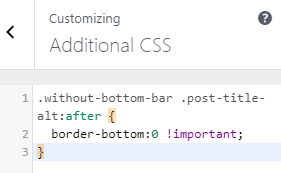
Precautions When Editing The WordPress Style.css File
- Before you proceed to edit your WordPress’ style.css file, make sure to back it up first.
- While editing the style.css file, take proper notes of the sections you edit, including opening and closing brackets and results in the browser.
- It is recommended to edit your style.css file locally on your computer. For this, you may need to install a local server on your computer and make the necessary changes to your site. Once you finalize your site’s style.css file, you can upload the updated style.css file to your hosting account.
- Use Chrome’s Inspect option to find the exact style sections on the web pages. Once you identify the sections, you can search your site’s style.css file for the sections and make necessary changes.
Conclusion
If you focus on the style.css file, you can get a list of your site’s theme CSS styles.
With that in hand, Chrome’s Inspect feature helps you find the style sections on your site’s pages. Proceed and make necessary changes, and see the results on the spot.
If, for example, you don’t prefer editing the style.css file, you can choose a lightweight theme while building your WordPress site.
To get more out of your theme, bundle it with a free WordPress drag and drop visual editor to customize how your site’s content will show on the pages.
Join the conversation in the comments, and let us know about your thoughts on dealing with the WordPress CSS styles.
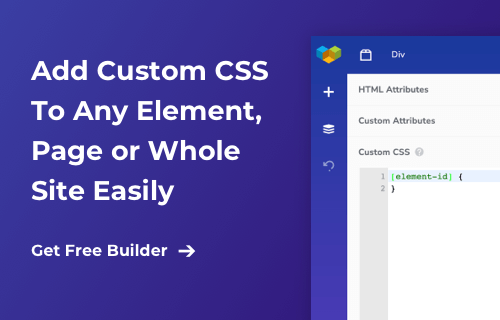

Fantastic. Just what I was looking for. THANK YOU.
Easy to follow, clear, and spot on real life example.
(not to mention a very charming presenter. WOW)
: )
I warmly suggest to all VC users to use CSS Hero to apply complex style to Visual Composer.
EG if you need to style only one page, you can use the bundled CSS editor, But if you need to commit CSS on certain pages or on some sections, you can speed up your workflow with CSS Hero.
It was such a great article which was on wordpress theme stylesheet. I would like to add some easy points which are as follows:
1.Visual Styling
2.Consistency
3.Responsive Design
4.Hierarchy and Structure
5.Customization
6.Integration with Plugins
7.Accessibility
8.Loading Efficiency
These are some points which I wanted to include in your article. Readers, If you want to create your wordpress website, you can visit an IT company like Alakmalak technologies. They have 17+ years of experience in this field.
You didn’t do the code for changing the text color on hover. That is what I really needed. Everything else was good! Thanks!